Residents of the near Mezen areas gathered in the village of Bolshaya Pyssa, Udora district, to honor the Mezen river on 12 August. Guests from such villages as Latyuga, Malaya Pyssa, Politovo, Patrakovo, Melentyevo, Muchkas, Syolyb, Koslan, and also the old Vozhgora village located in Leshukonye district, Arkhangelsk region, came to the inter-village Mezen Day event arranged for the first time by the Silver Taiga Foundation for Sustainable Development. In total 400 people participated in the celebration.
“For five years already the Silver Taiga Foundation supported by Mondi Group has been implementing the Model River Project – Sustainable Fishery Resource Management in Cooperation with the Local Population in Udora district. Under the project, meetings are conducted at various grounds – at conferences, workshops, the project working group meetings, at AgroUdora cooperative, in rural settlements, and we discuss both on the district and regional levels how we can manage this huge and complex asset (the river length is almost one thousand kilometers) sustainably. The Mezen flows from the Timan rocks to the White Sea. And as the five years passed have shown, there is a certain progress. More and more enthusiasts join us, schoolchildren are also active in the project, and we hope that this event will serve as a uniting start for preservation of the river resources – fish and forest growing by the river,” announced Yury Pautov, the Silver Taiga Foundation director, at the opening ceremony.
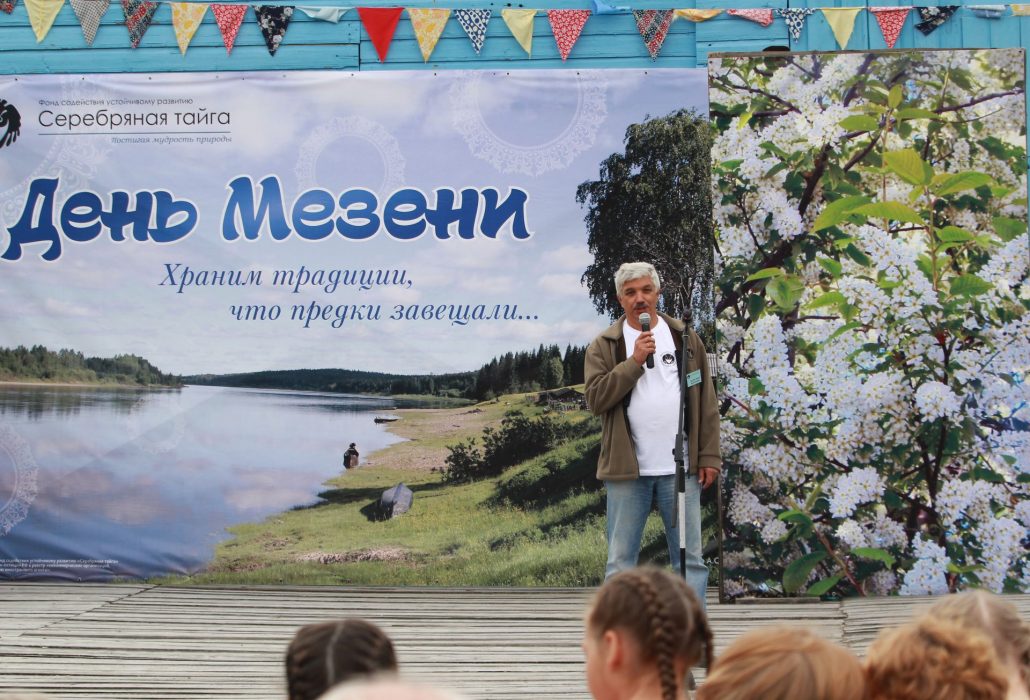
Silver Taiga Director Yury Pautov
The Mezen flows across three districts – Udora district in the Komi Republic, Mezen and Leshokonye districts in Arkhangelsk region. With no good roads available, the river has served as an only means of communication between the residents of near Mezen areas for long. Till the end of the previous century districts had strong ties, people travelled to each other, intercommunicated, made families, while in recent years the connecting bonds have been getting loose.
“We want to help the river to preserve its primeval nature, its beauty, its biodiversity, its most valuable resources. Life shows that human actions do not always contribute to it. And so as each of us understood how important it is, we sometimes need to remind ourselves of the role of the river in our life, give the hard-working, beautiful, fostering river what it deserves… Officially speaking, the main objective of the event is to draw the attention of the public and authorities to the issue of the need to preserve the resources of one of the most important rivers of the North. The river knows no borders, so we can only conserve its assets altogether in mutual understanding and cooperation with each other. It is not possible to reproduce and multiply fishery resources locally, in one place only, the environmental bodies and local communities of the three districts have to act jointly. So, in order to unite the efforts of all stakeholders this celebration was organized,” deputy director of the Silver Taiga Foundation Valentina Semyashkina explained.
The program of the festival also included the environmental education part, for example, a lecture on ichthyology, regional study quiz, intellectual game What? Where? When?. The lecture by Nikolay Shilov, coordinator of the Model River Mezen project, unexpectedly raised much interest – there were a lot of those who were willing to learn the details of the life of the Mezen fish population.
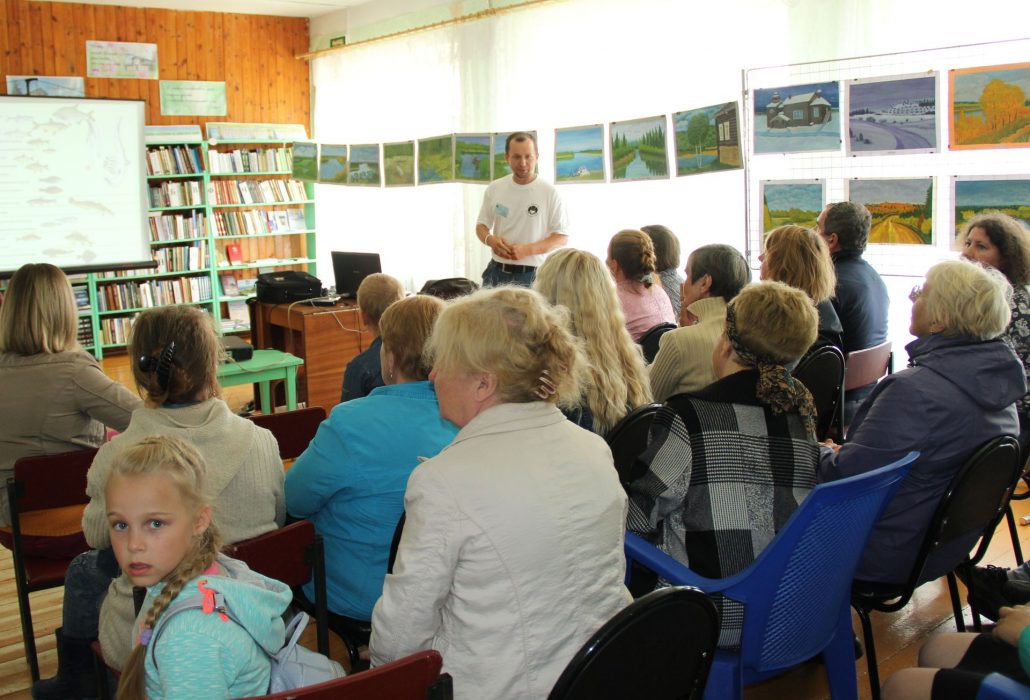
N. Shilov is giving a lecture
A lot of village residents came to support their fellow villagers at the What? Where? When? game. The Model River Mezen project working group played against the local experts. To the great joy of the experts and sadly for the working group members, the game was won by Bolshaya Pyssa residents. The best player was acknowledged to be Mikhail Selivanov, and the best question was asked by Alexey Vurdov, who got a prize for it.

Mikhail Selivanov was considered as the best player of the “What? Where? When?” game
“In near Mezen settlements the many centuries old culture – traditions and customs, folklore and cuisine, songs and dialects – are still preserved. And today hardworking and talented people – craftsmen, who know and love their native land – live near the Mezen. So, this event is a good opportunity for them to show their results, and for us to thank them. It is primarily a brotherhood celebration,” Alexey Vurdov shared his impressions.
At the Mezen Day, the Udora writer acted in an unusual role and demonstrated to the visitors the recipe of a traditional Udora dish “lul” normally offered to the dearest guests on most important holidays. Only selected guests could try the delicacy, but everyone else was treated with the fish soup cooked according to old Mezen recipes. The fish soup was cooked in a big pot at the most slightly spot, and having absorbed the smoke of the fire it was extremely tasty.
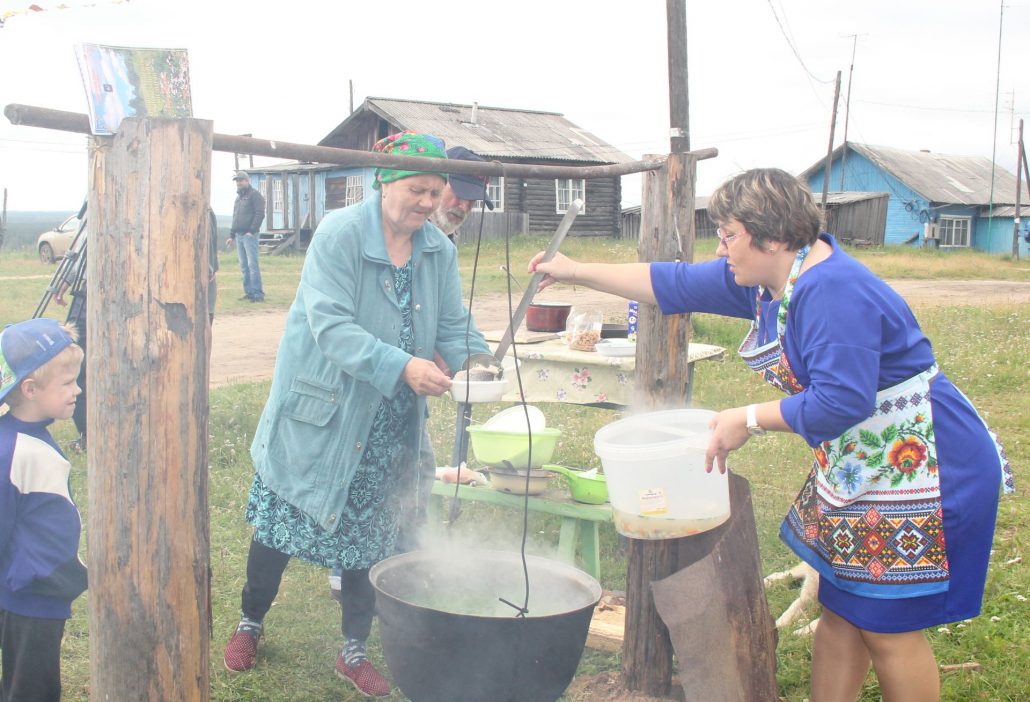
Tasting the fish soup
The regional study quiz was conducted at the ground near the exhibition of books with contents related to the Mezen area. It turned out, the Udora residents do not know their native area well, and the facts they heard at the quiz show were a discovery for many of them. The right answers were awarded with tokens, and those who had most of the tokens received prizes – tea mugs with the same picture displaying the landscape of the area as was on the banner decorating the scene.
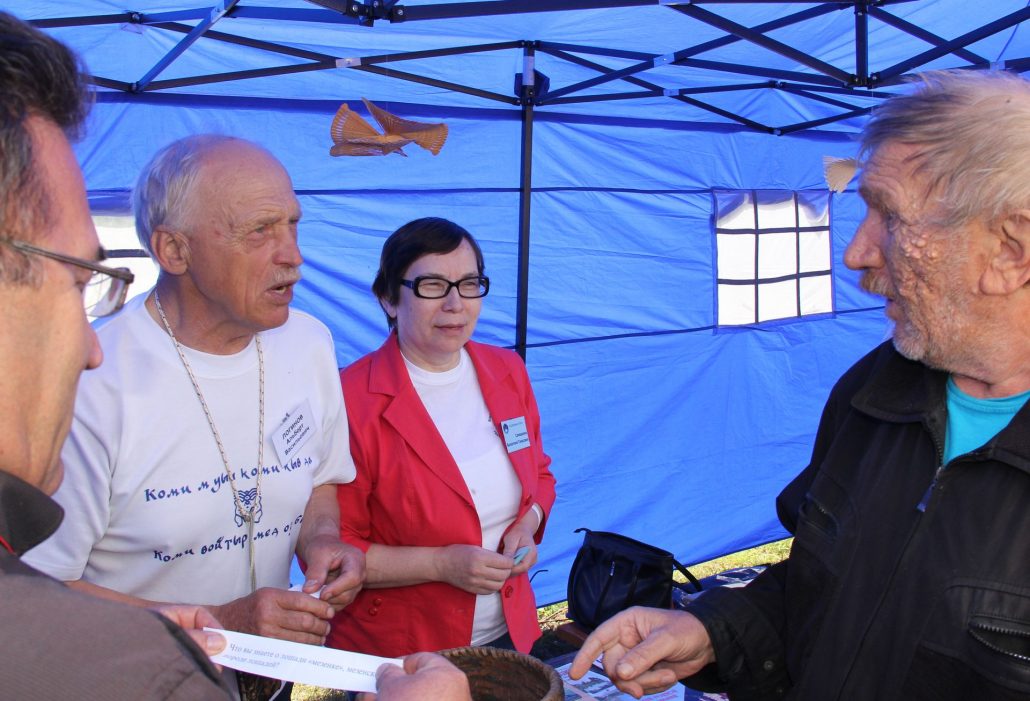
Regional natural history aroused a great interest among the participants
In a tent camp near the Bolshaya Pyssa Recreational Center local craftsmen Vladimir Bushenev, Oxana Baklanova and Nikolay Matveev conducted traditional arts and crafts workshops. Adults and kids were obsessed with the bark pipe making process, they painted wooden plates with traditional Mezen ornaments, and the youngest participants colored fishes made of plywood with paints.
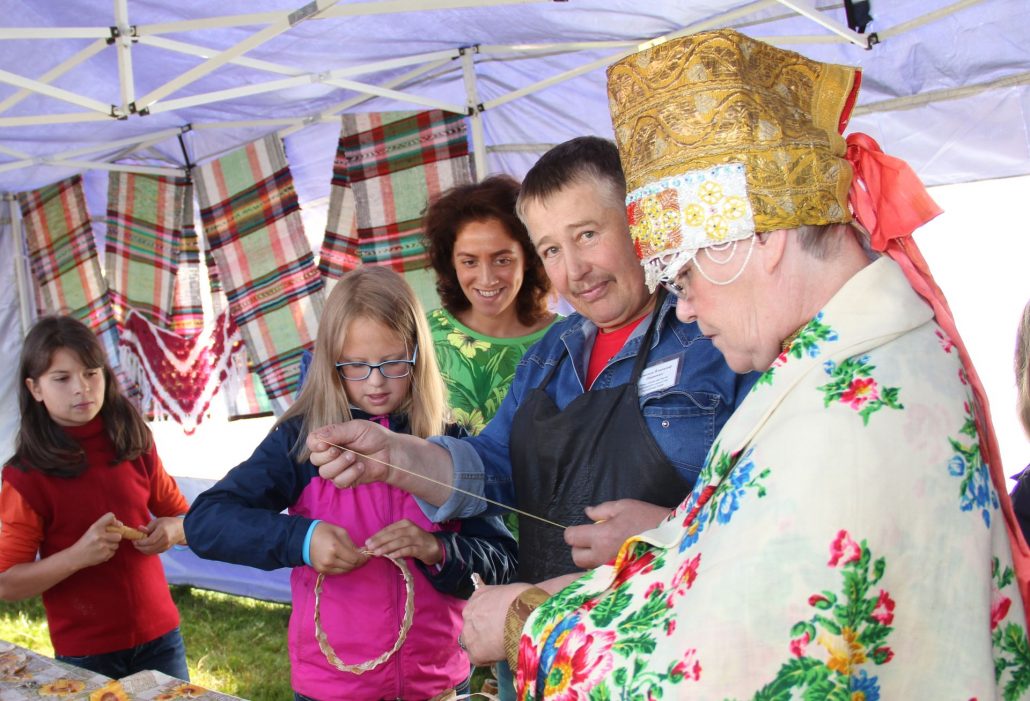
Vladimir Bushenev is giving a master class
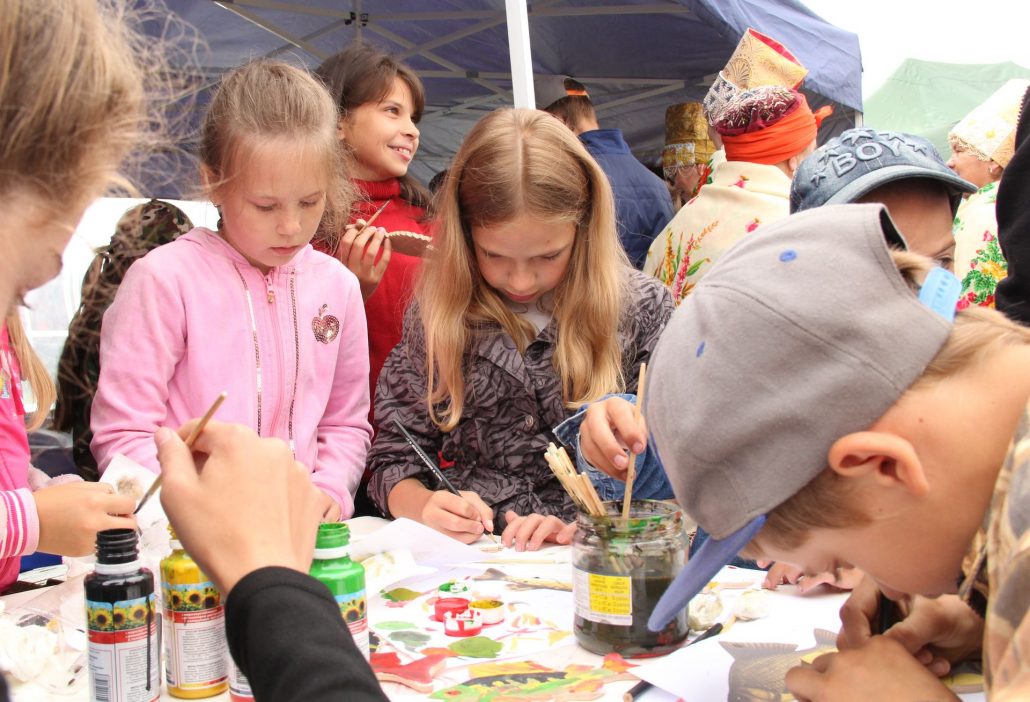
The young participants are in the painting class of N. Matveev
During the festival, meetings with Udora poets Anastasia Busheneva, Nina Obreskova and Svetlana Govorukhina were arranged in the hall of the Pyssa library.
The “newly-crowned” citizen of honor of Udora district Albert Loginov (he got the certificate validating the title right at the opening ceremony of the inter-village celebration from Nikolay Zhilin, head of the district administration) gave a master-class on how to make a Mezen boat, which is called “zyryanka” in Arkhangelsk region. The structure of the boat is known to be referred to the Vym type. There are almost no craftsmen able to build such a boat by the Mezen left, and the only one who knows the secrets of the ancient craft in the village is Albert.
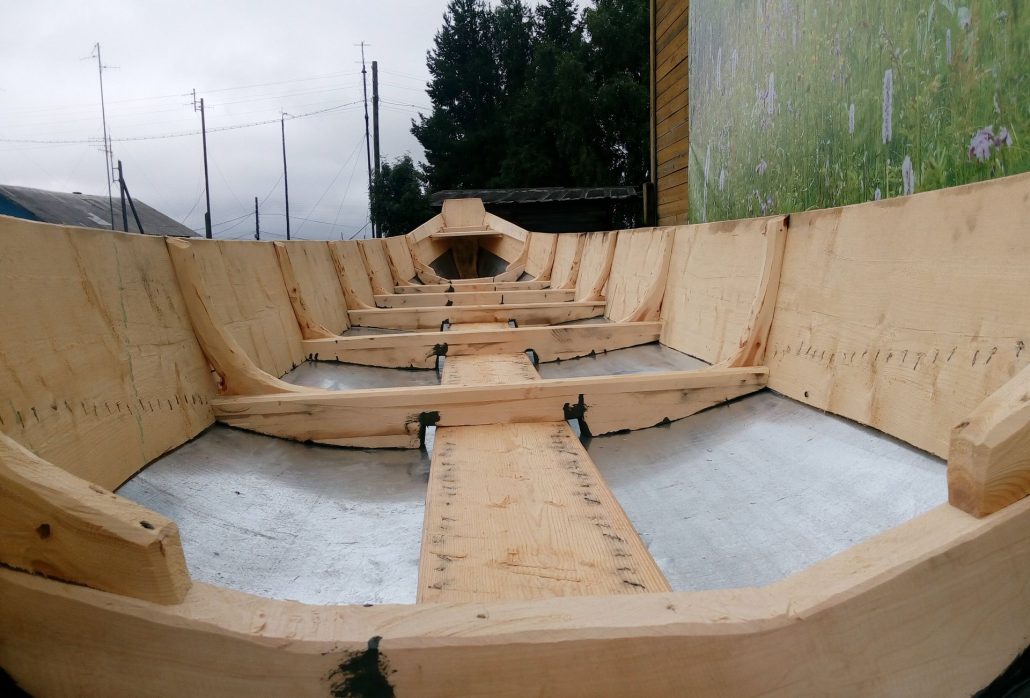
The Mezen boat made by Albert Loginov
Also, the exhibition of the paintings by Nikolay Pavlov, born in the village of Latyuga, was opened at the festival. The works depict natural landscapes well known to the local residents, and each of the visitors to the exhibition was eager to compare the painter’s vision with own impressions. The exhibition made them proud of their native land. Irina Tarabukina, the painter’s daughter living in Syktyvkar, also came for her father’s exhibition opening. She told the fellow villagers about her father’s art, his life and the history of some of his paintings.
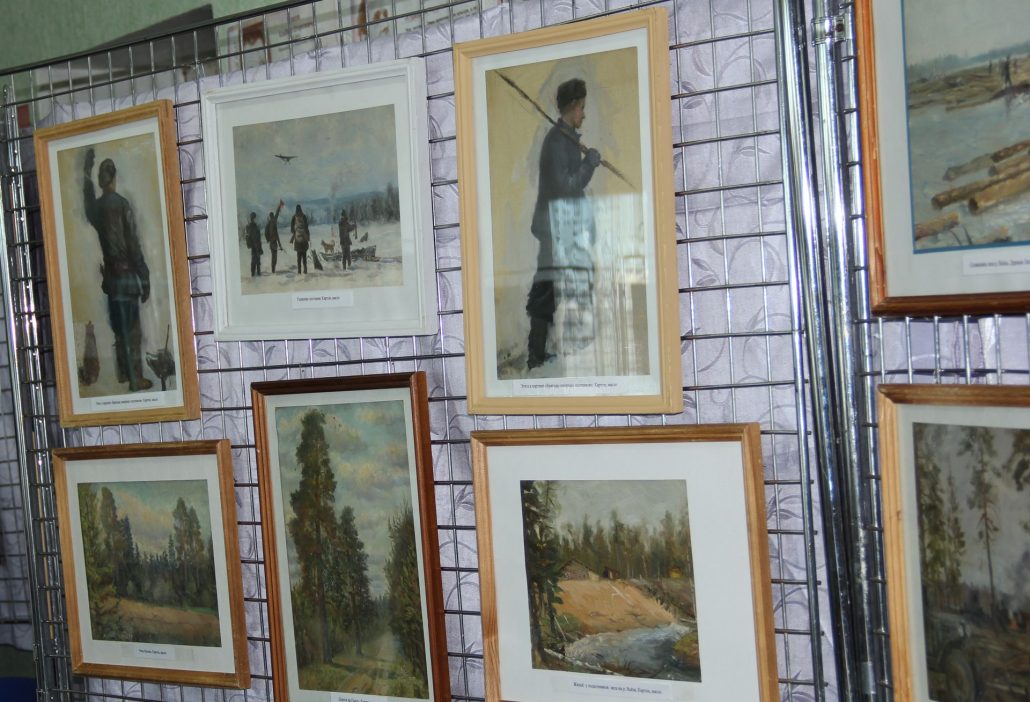
The paintings of Ivan Pavlov – a native of Udora (Latjuga village)
Here, the visitors could observe the paintings by Nadezhda Loginova, who spends each summer in her native village Bolshaya Pyssa.
At the end of the celebration, visitors could enjoy the performance of folk bands – Vozhgora folk choir from the neighboring Arkhangelsk region, Poloznicha artist band from Syolyb, folk band Zabavushka from Politovo, folk choir Lovya Va from Koslan, dance band Assorti and folk band Sostom Yol from Bolshaya Pyssa.
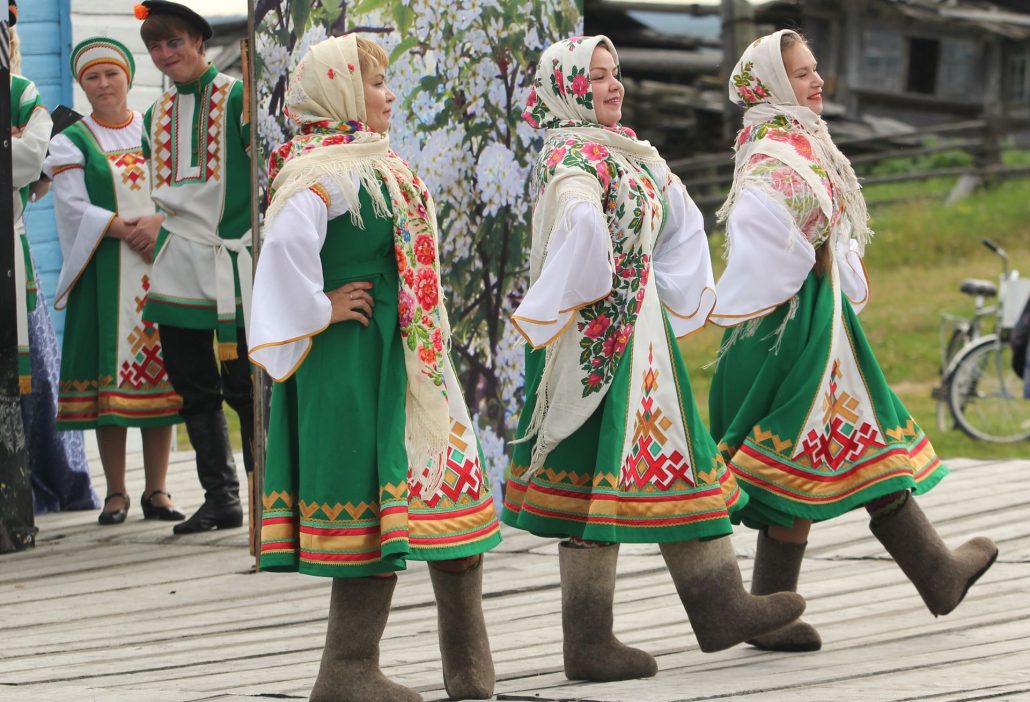
The local amateur-talent group
Almost all organizations and institutions of the village, including the administration, Recreational Center of Pyssa, Pyssa Secondary School, Udora Centralized Library System, Veterans Council and Women Council of Bolshaya Pyssa supported actively the festival facilitation.
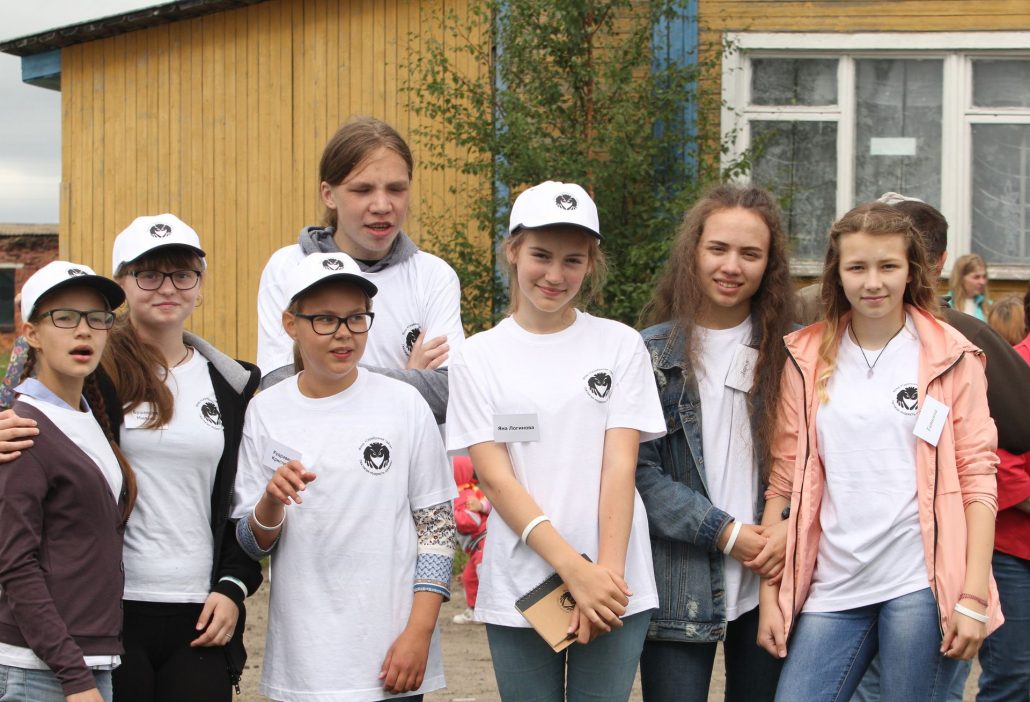
The volunteers assisted during the event
***
Mezen is one of the cleanest rivers in Europe. Its length from the riverhead to the estuary is 966 km. Mezen is the second river after the Northern Dvina in terms of the amount of water it brings to the White Sea. On its way to the White Sea the Mezen is nurtured by 15,187 rivers and streams. The bed of the river sometimes narrows and sometimes widens. The width of the river – 15 meters initially – increases to 40 meters gradually.
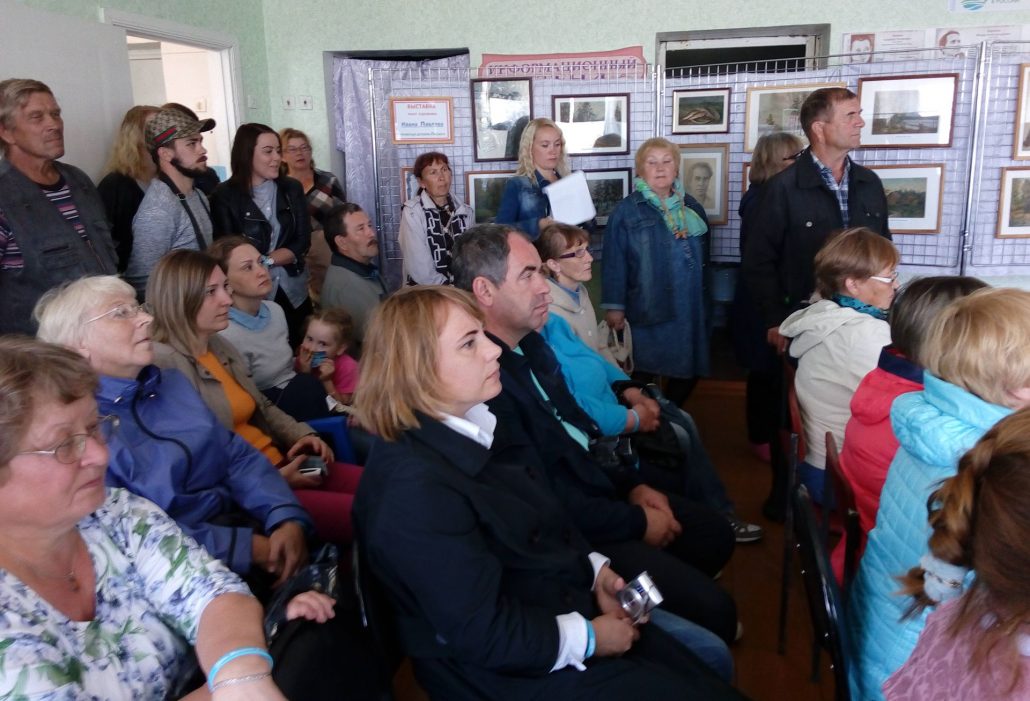
The local population want to learn something new about the native region

The guests have come from all over the region

The greatest event
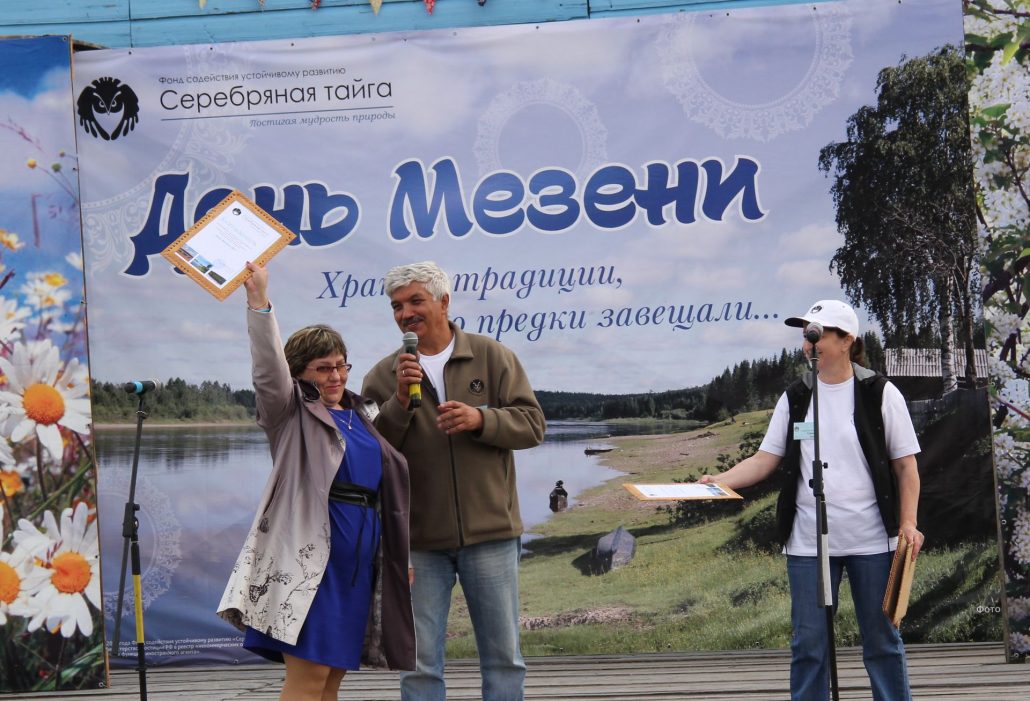
Awarding ceremony

The organizers of the event
Silver Taiga Completed Forest Certification Training
| News by Just AuthorThe training course was conducted for employees of Mondi Syktyvkar and its contractors to meet the company’s request. The agenda of the course was focused on such aspects as reforestation, biodiversity conservation, soil and water protective functions of the forest, assessment and minimization of the environmental impact.
Mondi Syktyvkar is the company performing voluntary forest certification under the schemes of the Forest Stewardship Council (FSC) and PEFC, each year it proves its compliance with the standards based on the results of external audits. During the audits experts pay special attention to the logging procedure and whether it meets the environmental requirements of the standards, that is why the company conducts additional training for the employees involved in logging operations and contractors performing delineation services.
The training under the Planning and Organization of Logging Operations in Line with the National FSC Standard – Environmental and Forest Management Aspects was conducted in the field conditions. Over 170 people, mostly harvesting equipment operators and foremen, as well as delineation experts, improved their skills. All trainees passed a final test upon completion of the course and they will get certificates subsequently. For the period of five months Nikolay Shuktomov, Alexander Borovlyov and Nikolay Shilov from the Silver Taiga Foundation for Sustainable Development have arranged over 12 courses at 6 logging camps. Silver Taiga experts prepared demonstration sites in four Komi districts – Priluzye, Udora, Ust-Kulom, and Kortkeros, were Mondi Syktyvkar leased areas are located. Typical objects were selected for each area, and foremen and operators were explained what they did well, and what they had to improve. The trainees were also provided with workbooks, operation sheets, printed space images and aerial surveys.
Descriptive material prepared by the Foundation’s experts quickened the trainees’ interest
Harvesting equipment operators were most interested in the training course. Studying the examples, they were eager to consider the topics related to minimization of negative environmental impact of logging, especially effect on soil, flora and fauna, discussed and offered problem solutions. Trainers of the course put emphasis to such sites at the demonstration routes where environmental criteria were met to the full, they took efforts to make the trainees remember them and follow the example later on at work.
“The course schedule was tough, and the Foundation’s experts worked hard. So, it is nice to see the result, the course was useful both for the employees of logging operators, who upgraded their qualification, and the Foundation’s staff, because they allowed us to get a comprehensive vision of the way the production processes are organized at different logging areas of the company,” Nikolay Shuktomov, forestry project coordinator of the Silver Taiga Foundation, explained.
In addition, Silver Taiga managed to enlarge its data base by landscape images obtained through aerial survey by a drone in the course of the workshop. Over a thousand and a half of images were taken, now they are to be analyzed and systematized. The aerial survey will allow to assess the situation in the forest comprehensively, to understand what happens during logging operations and observe the cause-and-effect relations.
Aerial survey of a key biotope preserved by loggers in Udora district
Environmental experts state that delineation quality differs in different districts. Most delineation issues were raised in Ust-Kulom district. That is why a special focus was given to the course in Ust-Kulom (in particular, to conduct a drill for delineation specialists), and several demonstration sites were prepared in different forestries.
Landscape borders and key elements are studied at a logging plot
Based on the results of inspection of logging areas during the preparation and implementation phases of the course, a note will be drawn for the Mondi Syktyvkar management to provide the analysis of the status at each area to ensure additional monitoring during the assessment of the company’s environmental footprint.
A group of trainees at the course in Udora district
Photos by N.Shilov, S.Davydov and V.Shuktomov
Global Climate Change and Clear Felling Scale Discussed at International Forest Summer School in Komi
| News by Just AuthorRegular studies of the International Forest Summer School facilitated by Syktyvkar Forest Institute and arranged jointly with its partners, Silver Taiga, Mondi Syktyvkar, and Komi Fire Fighting Center, were held from 3 to 16 September in Komi. The annual course was attended by students of foreign universities.
For several years experts of the Silver Taiga Foundation for Sustainable Development have participated in the event through sharing their experience and the results of the Priluzye Model Forest project, as well as a number of other projects. This time, the course has been attended by nine forestry students from three different German universities and one student from Sweden. On the second day, a lecture on forestry specifics in Russia and Komi and regularities of natural taiga forest dynamics was given by Yury Pautov, director of the Silver Taiga Foundation. Germany is dominated by temperate zone forests, mostly deciduous, so it was necessary for the German students to get acquainted with the character of forest management in the Northern taiga.
On the following days, during field studies, the visitors walked along the three demonstration routes of the Priluzye Model Forest, a logging camp of the Luzales company, and an operating logging site of Mondi Syktyvkar in the Noshul district forestry. The future forest engineers were eager to learn about functioning of forestry sector in Russia, differences between the forest management rules in Russia and European countries, compare forest exploitation history in different countries. They were particularly impressed by the size of clear felling area in Komi. The maximum clear felling area in Germany should not exceed three hectares, and even such size is rare. Germans, as a rule, prefer selection felling. So, the visitors were interested in the biodiversity preservation system applied in certified forests.
Forest management history is interesting both for Russian, and foreign students
The foreign students were much surprised about the fact that local people sell mushrooms and berries by the roads near residential areas. People do not do it in Germany. They also found themselves lucky to see traces of wild animals – a she-bear with bear cubs and a couple of wolves. It turned out that wolves are protected by the state in Germany, and they can only be hunted under a license in specially allocated areas. The foreign guests found it exotic that bears in Komi hang out by highways hoping to be fed, and wolves come to villages in winter and scare the locals, as was told by Yury Pautov.
Daily taiga management practices were presented at the meeting with Yury Serditov, deputy head of the Priluzye forestry. He told the students about the effective forestry legislation and the features of the Russian forest management system. The German students were surprised about the fact that foresters in Russia are no more than just state inspectors, while in Germany they are fully responsible for all the activities conducted within the forestry, including wood cutting and hunting. The German visitors also noted that forest fires in Germany are extraordinary events, because the temperate zone forests are dominated by hardwood species – beech, oak, ash. So, they had a lot of questions with regard to the dynamics and consequences of fires. They were also interested in the methods currently used in Komi for fire fighting and fire prevention.
“Such international forest summer schools are very useful both for students, and for trainers, because they allow seeing forest as a global worldwide resource necessary to ensure survival of the mankind. In particular, discussions with the students from Germany revealed the different approaches to climate change in different countries. Few people focus on the issue in Russia now. At a meeting in Priluzye forestry the students asked what norms for adjustment to climate change are used in Komi forest sector??? Neither myself, nor deputy head of the forestry could clearly answer the question, because Russia simply has no such norms. Climate change takes place globally and locally, and that is clear from more frequent extreme weather conditions, like hurricanes, winter thaw, droughts, floods. A good example was last summer, when Northern districts of Komi suffered of uncommon heat, there were forest fires in forest taiga, while Southern districts were flooded by continuous rain. Such extreme weather conditions undoubtedly lead to weakening of forests, which results in outbreak of parasites propagation and forest diseases. Many foreign countries have already developed measures for forestry adaptation to upcoming climatic changes, but in Russia only scientists and few experts speak about the necessity of such measures,” Yury Pautov summed up the course.
At the route showing regularities of natural taiga forest dynamics
Studied Fish Scales Microscopically and Made a Fire with a Stone
| News, «Model river «Mezen» project by Just AuthorFrom 21 to 25 August, the Summer Ichthyologic School was held in Vazhgort, Udora district, as part of the Model River Mezen project, jointly with the Usogorsk Children Recreational Center, Komi Republic Center of SPNA, with the support of the Vazhgort Secondary School. The participants were kids from different places – Syktyvkar, Usogorsk and Vazhgort. In total, there were 18 participants, four adults and 14 schoolchildren aged from 13 to 16.
“The Summer Ichthyologic School has operated for three years already, and for all this time we have found the method to make both newcomers and permanent students interested. The schoolchildren obtain basic skills of biological material handling. Many of the kids make reports based on the knowledge they get and present them at various forums, for example at the Motherland – Komi Land conference, but the purpose is not to write a research work,’ Nikolay Shilov, initiator and director of the Ichthyologic School, coordinator of the Model River Mezen project, says.
N. Shilov is giving a lecture
At the training session he told the children about the Mezen ichthyofauna, the fish anatomy, methods of fish stock keeping, human role in preserving bioresources, and conducted practical lessons.
Practical training
Training was held in the Vazhgort Secondary School, and there was a good reason to choose the venue. In the first year the research was conducted at the Irva river in the area of the upper reaches of the Mezen, in the second year the school was arranged in the village Bolshaya Pyssa near the middle reaches of the river, and now the focus was on the Mezen tributary – the Vashka – and the Kula river flowing into it.
The program was targeted on teaching the schoolchildren how to determine the composition of the fish population in the Vashka basin with available methods. So, the kids accompanied by adults went fishing, caught fish and prosected it. By analyzing the scale under the microscope they estimated the age of fish, looked for parasites and defined them.
The underwater world under the microscope is even more interesting
This year, the school used new entertaining teaching methods. For example, the schoolchildren studied the anatomy of fish with the help of puzzles, watched a video on artificial fish reproduction and the state of industrial fishing in the Komi Republic.
Fish skeleton puzzle
Also, during the session the schoolchildren conducted a survey among local fishermen to get to know the details of the species composition of the fish, asked about the causes of increase or reduction of the population, were interested about the tools used to catch fish and assessed the overall state of the fishery resources. The survey revealed a lot of new information for the students, some of the answers puzzled them. For example, the locals told them that they had started seeing bull-trout in the Vashka, but the description given identified that they mix the bull-trout up with other salmon species. The children specially noted that the fishermen believed it was necessary to restrict catchment during the spawning period to preserve the fish population.
Interviewing the fisherman
Guided by Margarita Shilova, senior expert of environmental education department, Center of SPNA, the children conducted assessment of the quality of surface water in the Vashka and the Kula and tried to make a filter for water in the field conditions. With the help of test-strips and the portable Bee-Bio lab they learned how to determine chemical properties of water. Most results enabled them to draw a conclusion that the water quality was good even with dark colouring. The expert also had an informative lecture about the Red Book of the Komi Republic upon completion of which the children were able to find the conserved species of plants, animals, insects inhabiting the Udora district.
The kids also performed as experts in an environmental game and managed successfully to find solutions for ecological problems.
A representative of the Center of SPNA conducted a workshop for teachers under the extended training course Reserved School, and some game lessons for the children.
What the students were most impressed by were the tours facilitated by Irina Klishch, director of the Vazhgort Secondary School. During such trips she informed the kids about the diversity of species of plant communities near Vazhgort. Additionally, the kids learned how to survive in the forest, they were taught to make fire with a stone, to find their way in the forest with the help of compartment lines and water bodies. The schoolchildren also visited the local fire brigade where they were told about how to behave in emergency situations. And on the last day the young ichthyologists went to the Vazhgort museum. The kids also played sports – volleyball and other active games. The leisure activities were organized by Nadezhda Morozova from the Usogorsk Children Recreational Center.
“It is great that at the end of the session all children had a huge desire to join the summer ichthyologic school next year. They offered to make a list of additional topics jointly with instructors. For example, they recommended to include the detailed study of a skeleton of bony fish,” Nikolay Shilov summed up the results of the Summer Ichthyologic School.
Visiting the fire station
Photos by Nikolay Shilov
«Learning From Nature»
| News, «Model river «Mezen» project by Just AuthorThis was the name of the stage play prepared by the student propaganda team for the population of Chuprovo, Bolshaya Puchkoma and Muftyuga villages of Udora district of Komi under Model River Mezen Project. The students’ performances in Udora district at the end of each summer season have become already a good tradition.
On August 5 the students acted in Chuprovo village and the next day they went to Bolshaya Puchkoma and Muftyuga villages. The team was in particular warmly met in Bolshaya Puchkoma village as the students had to cross Vashka River during the spring flood. The audience hall in the Community Center was almost full. The students visited Chuprovo and Muftyuga villages last year. As for Bolshaya Puchkoma village, the students visited it for the first time.
Crossing Vashka River
The team enlarges every year by the new volunteers from among the students. This year the propaganda team consisted from the Komi Republican Agroindustrial Technical School leavers Christina Ekimova and Dmitry Kazarinov, the student of Art Gymnasium of Komi Victoria Tushkanova and the student of Syktyvkar Trade School №34 Andrey Korovin. The students were assisted by Edva village Secondary School physical training teacher Natalia Politova as well as the representatives of Chuprovo village library Alexander Korovin and Zhanna Korovina.
Just landed
The propaganda team showed the ecological tale, sang chastushkas (two-line or four-line folk verse on a topical or lyrical theme) and songs. The students acted on behalf of the personified Udora lakes and rivers requesting to care with respect to natural resources.
Episode of the performance
«Next year we are planning another action of the propaganda team as we see the results of our work, our performances give pause for thought about nature. Especially school and preschool children appreciate our work», says the leader of the propaganda team Christina Ekimova.
If only the rivers and lakes could speak…
Honoring the Mezen, Beautiful River, Fostering River
| News, «Model river «Mezen» project by Just AuthorResidents of the near Mezen areas gathered in the village of Bolshaya Pyssa, Udora district, to honor the Mezen river on 12 August. Guests from such villages as Latyuga, Malaya Pyssa, Politovo, Patrakovo, Melentyevo, Muchkas, Syolyb, Koslan, and also the old Vozhgora village located in Leshukonye district, Arkhangelsk region, came to the inter-village Mezen Day event arranged for the first time by the Silver Taiga Foundation for Sustainable Development. In total 400 people participated in the celebration.
“For five years already the Silver Taiga Foundation supported by Mondi Group has been implementing the Model River Project – Sustainable Fishery Resource Management in Cooperation with the Local Population in Udora district. Under the project, meetings are conducted at various grounds – at conferences, workshops, the project working group meetings, at AgroUdora cooperative, in rural settlements, and we discuss both on the district and regional levels how we can manage this huge and complex asset (the river length is almost one thousand kilometers) sustainably. The Mezen flows from the Timan rocks to the White Sea. And as the five years passed have shown, there is a certain progress. More and more enthusiasts join us, schoolchildren are also active in the project, and we hope that this event will serve as a uniting start for preservation of the river resources – fish and forest growing by the river,” announced Yury Pautov, the Silver Taiga Foundation director, at the opening ceremony.
Silver Taiga Director Yury Pautov
The Mezen flows across three districts – Udora district in the Komi Republic, Mezen and Leshokonye districts in Arkhangelsk region. With no good roads available, the river has served as an only means of communication between the residents of near Mezen areas for long. Till the end of the previous century districts had strong ties, people travelled to each other, intercommunicated, made families, while in recent years the connecting bonds have been getting loose.
“We want to help the river to preserve its primeval nature, its beauty, its biodiversity, its most valuable resources. Life shows that human actions do not always contribute to it. And so as each of us understood how important it is, we sometimes need to remind ourselves of the role of the river in our life, give the hard-working, beautiful, fostering river what it deserves… Officially speaking, the main objective of the event is to draw the attention of the public and authorities to the issue of the need to preserve the resources of one of the most important rivers of the North. The river knows no borders, so we can only conserve its assets altogether in mutual understanding and cooperation with each other. It is not possible to reproduce and multiply fishery resources locally, in one place only, the environmental bodies and local communities of the three districts have to act jointly. So, in order to unite the efforts of all stakeholders this celebration was organized,” deputy director of the Silver Taiga Foundation Valentina Semyashkina explained.
The program of the festival also included the environmental education part, for example, a lecture on ichthyology, regional study quiz, intellectual game What? Where? When?. The lecture by Nikolay Shilov, coordinator of the Model River Mezen project, unexpectedly raised much interest – there were a lot of those who were willing to learn the details of the life of the Mezen fish population.
N. Shilov is giving a lecture
A lot of village residents came to support their fellow villagers at the What? Where? When? game. The Model River Mezen project working group played against the local experts. To the great joy of the experts and sadly for the working group members, the game was won by Bolshaya Pyssa residents. The best player was acknowledged to be Mikhail Selivanov, and the best question was asked by Alexey Vurdov, who got a prize for it.
Mikhail Selivanov was considered as the best player of the “What? Where? When?” game
“In near Mezen settlements the many centuries old culture – traditions and customs, folklore and cuisine, songs and dialects – are still preserved. And today hardworking and talented people – craftsmen, who know and love their native land – live near the Mezen. So, this event is a good opportunity for them to show their results, and for us to thank them. It is primarily a brotherhood celebration,” Alexey Vurdov shared his impressions.
At the Mezen Day, the Udora writer acted in an unusual role and demonstrated to the visitors the recipe of a traditional Udora dish “lul” normally offered to the dearest guests on most important holidays. Only selected guests could try the delicacy, but everyone else was treated with the fish soup cooked according to old Mezen recipes. The fish soup was cooked in a big pot at the most slightly spot, and having absorbed the smoke of the fire it was extremely tasty.
Tasting the fish soup
The regional study quiz was conducted at the ground near the exhibition of books with contents related to the Mezen area. It turned out, the Udora residents do not know their native area well, and the facts they heard at the quiz show were a discovery for many of them. The right answers were awarded with tokens, and those who had most of the tokens received prizes – tea mugs with the same picture displaying the landscape of the area as was on the banner decorating the scene.
Regional natural history aroused a great interest among the participants
In a tent camp near the Bolshaya Pyssa Recreational Center local craftsmen Vladimir Bushenev, Oxana Baklanova and Nikolay Matveev conducted traditional arts and crafts workshops. Adults and kids were obsessed with the bark pipe making process, they painted wooden plates with traditional Mezen ornaments, and the youngest participants colored fishes made of plywood with paints.
Vladimir Bushenev is giving a master class
The young participants are in the painting class of N. Matveev
During the festival, meetings with Udora poets Anastasia Busheneva, Nina Obreskova and Svetlana Govorukhina were arranged in the hall of the Pyssa library.
The “newly-crowned” citizen of honor of Udora district Albert Loginov (he got the certificate validating the title right at the opening ceremony of the inter-village celebration from Nikolay Zhilin, head of the district administration) gave a master-class on how to make a Mezen boat, which is called “zyryanka” in Arkhangelsk region. The structure of the boat is known to be referred to the Vym type. There are almost no craftsmen able to build such a boat by the Mezen left, and the only one who knows the secrets of the ancient craft in the village is Albert.
The Mezen boat made by Albert Loginov
Also, the exhibition of the paintings by Nikolay Pavlov, born in the village of Latyuga, was opened at the festival. The works depict natural landscapes well known to the local residents, and each of the visitors to the exhibition was eager to compare the painter’s vision with own impressions. The exhibition made them proud of their native land. Irina Tarabukina, the painter’s daughter living in Syktyvkar, also came for her father’s exhibition opening. She told the fellow villagers about her father’s art, his life and the history of some of his paintings.
The paintings of Ivan Pavlov – a native of Udora (Latjuga village)
Here, the visitors could observe the paintings by Nadezhda Loginova, who spends each summer in her native village Bolshaya Pyssa.
At the end of the celebration, visitors could enjoy the performance of folk bands – Vozhgora folk choir from the neighboring Arkhangelsk region, Poloznicha artist band from Syolyb, folk band Zabavushka from Politovo, folk choir Lovya Va from Koslan, dance band Assorti and folk band Sostom Yol from Bolshaya Pyssa.
The local amateur-talent group
Almost all organizations and institutions of the village, including the administration, Recreational Center of Pyssa, Pyssa Secondary School, Udora Centralized Library System, Veterans Council and Women Council of Bolshaya Pyssa supported actively the festival facilitation.
The volunteers assisted during the event
***
Mezen is one of the cleanest rivers in Europe. Its length from the riverhead to the estuary is 966 km. Mezen is the second river after the Northern Dvina in terms of the amount of water it brings to the White Sea. On its way to the White Sea the Mezen is nurtured by 15,187 rivers and streams. The bed of the river sometimes narrows and sometimes widens. The width of the river – 15 meters initially – increases to 40 meters gradually.
The local population want to learn something new about the native region
The guests have come from all over the region
The greatest event
Awarding ceremony
The organizers of the event
Pike Will “Clean” the Irva Lakes
| News, «Model river «Mezen» project by Just Author200 thousand young pikes were released to the Irva river (the Mezen tributary) in Udora district at the expense of the Silver Taiga Foundation for Sustainable Development on 30 June. The juvenile fish release was attended by Vladimir Maltsev, temporary acting head of the Komi branch of the Federal Fishery Agency (GlavRybVod), and Nikolay Zhilin, head of Udora district administration.
The young pikes were delivered to the village of Glotovo by trucks, and then were transported along the Irva by boat. They were released to the river by Krivushevo near the AgroUdora cooperative fishery plot. Stocking of the river with fish was part of the Foundation’s Model River Mezen project.
The event was preceded by lots of work. First of all, a recommendation of the N.M. Knipovich Polar Research Institute of Marine Fisheries and Oceanography (Murmansk) was obtained. Then, based on the recommendation, a permission was issued to allow young pike release to the Mezen within Udora district. The fish was grown at the research facility of the Komi branch of GlavRybVod.
“Owing to well-coordinated efforts of the Komi branch the needed amount of juvenile fish was brooded, timely delivered and released to the Irva. It is worth to note that pike is not the most popular species for artificial reproduction. The grayling, cisco and other valuable fish species are subject to stocking more frequently. However, we decided to select the pike, as it has a huge food reserve in the Irva lake system. It mostly includes the roach and perch, which tend to grow in terms of their population due to progressing overgrowth of aquatic plants in the Irva lakes. The pike is expected to control the population of low-value fish species. At the same time, pike is demanded by the local population and has become a so-called “brand” of the Irva river”, says Nikolay Shilov, the Model River Mezen project coordinator.
The young fish handling
In 3-4 years, the youngsters released will provide almost half a ton of market fish. The AgroUdora cooperative will harvest the fish and sell it to local retail chains. Later on it is planned to expand the list of fish species recommended to be released to the Mezen. For instance, the cisco population is expected to be stocked.
The Irva lakes are a network chained by the Irva river. Therefore, their cleaning from aquatic plants by AgroUdora will become the following stage of the Model River Mezen project. During the reclamation, the weeds are planned to be taken out of water and composted. The test activities are expected at the end of this month.
The young fish
The river is stocked
Following Reserved Paths
| News, «High Conservation Value Forests» project by Just AuthorMondi Syktyvkar’s forestry division experts studied development specifics of intact forest massifs during the field workshop Regularities of the Landscape and Environmental Dynamics of the Pristine Taiga Forests held in the Pechoro-Ilych Reserve.
From 18 to 24 June 2017, a group of 9 Mondi Syktyvkar employees were trained at demonstration routes of the Pechoro-Ilych Reserve in the course of the training workshop facilitated by the Silver Taiga Foundation for Sustainable Development.
Since 2015 three groups of Mondi Syktyvkar experts responsible for harvesting planning and preparation, forest road construction, plot delineation and logging operations have visited the reserve. For them, participation in workshops is more than an opportunity to upgrade their qualification, it is a chance to take an exciting journey to the Pechoro-Ilych Biosphere Reserve, with its area included in the UNESCO World Heritage List. Very few people ever get a possibility to visit such a unique place; that is why for Mondi Syktyvkar employees such field workshops are considered as a reward for good service.
The group of the workshop participants by the hut at the Gusinoye (Goose) bog at the first demonstration route near the village of Yaksha
The contents of the workshop and its logistics were prepared well, and everything went smoothly. The administration of the Pechoro-Ilych Reserve has been interested in environmental tourism development recently, and it helps in arranging workshops and tours. “That time we were lucky with the weather – it was warm, but there were no mosquitos or other biting insects which often create discomfort for the field trip participants during the season. The spring-like high waters of the Pechora were also an advantage. Owing to that fact it took us less time to travel between different routes than usually”, said the workshop facilitator Yury Pautov, director of the Silver Taiga Foundation.
Mondi Syktyvkar employees could see three landscape areas of the reserve and learn about natural forest dynamics typical for Komi taiga. Each new route showed the development regularities of forest ecosystems and mechanisms of biota adaptation to various natural disturbances like creeping or crowning fires or windfalls. The workshop participants took much interest in Yury Pautov’s stories about the regularities of the centuries-old natural dynamics of virgin taiga forests, and more than that – about the history of Pechora district exploration in 18-20 centuries, about Old Believers having populated those places, about how the reserve was created, and the hard life and work of the reserve inspectors nowadays.
In addition, the participants of the workshop visited a unique Nature Museum of the Pechoro-Ilych Reserve and the moose farm with newly born moose calves, and when travelling across the reserve by boats they saw wild bears, beavers, hares and other taiga inhabitants.
At the moose farm – moose calves feeding
The Pechoro-Ilych State Biosphere Reserve jointly with the Yugyd Va National Park are part of the Komi Republic virgin forests, the first natural site in Russia which was included in the UNESCO World Heritage List. It is the biggest European massif of intact forests still functioning following its own laws for thousands years. That is why demonstration routes were developed and described here in 1996-1997, and later a training course for forestry experts was developed based on those routes in order to show the value of pristine forests and demonstrate the regularities of their dynamics in different landscapes. For the 20 years of the course, foresters and environmentalists from Sweden, Finland, Latvia, Poland, Russia, and, of course, the Komi Republic travelled the routes of the reserve.
Our motor men – the workshop would be impossible without them
Preventing Rash Action
| News, «High Conservation Value Forests» project by Just AuthorThe Foundation’s staff conducted a training course in FSC certification environmental aspects for employees of SLDK ltd.
How do you correctly delineate landscape boundaries? How do you define rare species? Why is it important to imitate natural forest dynamics when cutting? These and many other questions were answered by Silver Taiga’s representatives Nikolay Shilov and Alexander Borovlyov for SLDK ltd. personnel during the three-day course.
The field course was arranged at leased areas of SLDK ltd. near Diaserya, Ust-Kulom district, following the company administration request. On 16, 18 and 19 June, 60 people, including foremen, delineation experts and harvester operators, were trained. The participants were divided into 3 groups. Each of them had to pass a final test to complete the course.
SLDK’s employees are taking a test
“During the first days we were preparing the demonstration routes. Positive examples turned out to prevail over the negative ones. We didn’t find any gross violations, however we identified some minor issues. We were pleased to see that almost all participants of the course knew the basics of FSC certification. We covered all major aspects of soil preservation and minimizing impact on water bodies at logging plots. They were very much interested in identification and conservation of key biotopes, rare plant species, and topics related to use and disposal of fuel and lubricants. I’d like to note that compliance with the certification requirements is more than just a formality. We found some species recorded in the Red Book of the Komi Republic in some key biotopes which the company had decided to exclude from cutting plan,” said the environmental expert Nikolay Shilov.
The birds’ nesting sites have been conserved by the certification standards
All participants of the course were provided with checklists and satellite images demonstrating logging violations. Upon completion of the course each of the participants had to get a clear understanding of the landscape that is to be left after cutting is done. A special focus was paid by the Foundation’s experts on the trees which cannot be cut in any case.
SLDK ltd. passed the audit and got the FSC certificate two years ago. Before that time the company had had a so-called group certificate jointly with Mondi Syktyvkar. The reality is that management of SLDK ltd. is interested in upgrading the FSC certification qualification of its employees, which proves its serious approach to environmental aspects of forest use.
Photos by Sergey Davydov and Nikolay Shilov
About Forest Certification – to the Heads of the Rural Settlements
| News, «High Conservation Value Forests» project by Just AuthorSilver Taiga representatives conducted a training workshop on the voluntary forest FSC- certification for the heads of the rural settlements from Syktyvdin district of Komi on June 15.
What is the sustainable forestry and forest use? Why is the forest management certification a way to the sustainable forest management? How do the logging companies follow the social FSC requirements and what depends on the local communities and self-government? All these and other questions were answered to the workshop participants from Sludka, Mandach, Vylgort, Yb, Zelenets, Ozel and Shoshka villages.
There are several dozens of logging companies operating in Syktyvdin district of Komi. Among them are large companies including FSC-certified ones (Mondi Syktyvkar, SevLesPil ltd., North-West Forest Terminal ltd.), non-certified companies and individual entrepreneurs. There are many problems that the local people face because of the logging companies activities. First of all the condition of roads for general use leaves much to be desired as the roads suffer a lot of pressure from the logging trucks.
As it turned out during the workshop not all FSC-certified companies acting in the district fulfil the social requirements of the Standard. For example, only Mondi Syktyvkar inform the local administration about its plans of activities.
The heads of the rural settlements
How do the FSC-certified companies cooperate with the local communities, what are the ways of the local people interests consideration, how are the FSC requirements concerning the indigenous people fulfilled, what is HCVF and how are the social HCVFs defined, do the local people take part in working out of the social partnership agreement with the logging companies – all these issues were discussed during the workshop.
Antonina Kulyasova
Silver Taiga is going to continue such workshops on the FSC-certification social issues for the interested local people in the hope that they contribute to the development of the forest business social responsibility with respect to the local population.
The Silver Taiga Foundation Entered to Register of “Non-Profit Organizations Exercising Functions of a Foreign Agent”
| News by Just Author14 June 2017 – The Silver Taiga Foundation for Sustainable Development, with the history of its environmental projects in forestry districts of the Komi Republic lasting since 2002, was entered to the register of “non-profit organizations exercising functions of a foreign agent” by the Ministry of Justice of the Russian Federation.
The main reason why the Foundation’s activity was seen as “political” was the organization’s address to the Komi Republic governor with regard to the Decree on incorporation of the Ministry of Natural Resources into the Ministry of Industry signed by him. The address proposed to suspend the validity of the Decree and arrange consulting sessions with the stakeholders on whether such incorporation was reasonable based on the analysis of potential positive and negative effect. Participation in the working meeting on that topic, where the Silver Taiga Foundation director was invited by the Komi Republic governor’s Administration, was also considered as “political activity”. And even the Foundation director’s involvement in the work of the Public Environmental Council, which used to report to the Ministry of Natural Resources, but has been reporting to the Ministry of Industry this year, was also qualified as “political activity”.
“Our team has been working for almost two decades in the Republic”, says Silver Taiga’s director Yury Pautov. “Owing to our projects the Republic has allocated, assessed and is preserving intact forest massifs of high environmental value, it develops voluntary forest certification and supports local initiatives aimed at sustainable development of rural areas, domestic tourism development, environmental education and training for youth…. At field trips and educational workshops held by our staff in these years hundreds of forestry professionals and logging companies’ employees managed to upgrade their skills, hundreds of students and local residents learnt about the life of forest and sustainable forest management…. For the whole length of our service we have been actively cooperating and are still collaborating with the Republic’s environmental authorities, the state forest service, ministries, municipalities, regional and local public organizations, scientific and educational institutions…. No one has ever had an idea to accuse us of any political activity as a result of all stated.
Is it possible to implement large-scale environmental and sustainable development projects indeed without any contact with state authorities or local self-government bodies?! It is a rhetorical question. But anyway we have to ask it!
The Silver Taiga Foundation will contest its being included in the register of “non-profit organizations exercising functions of a foreign agent” in the court.